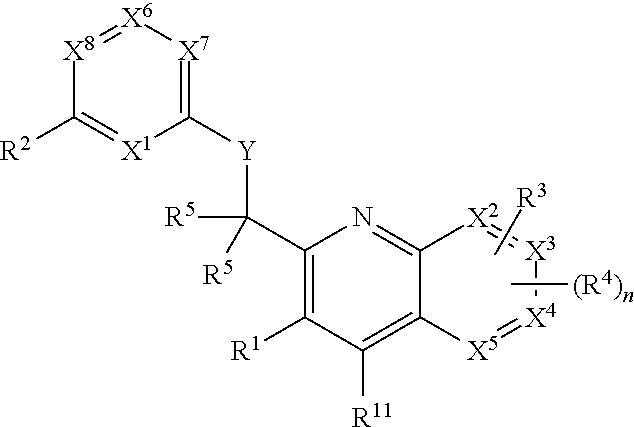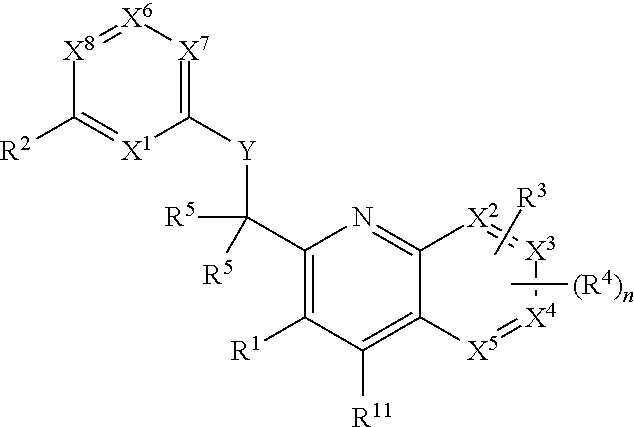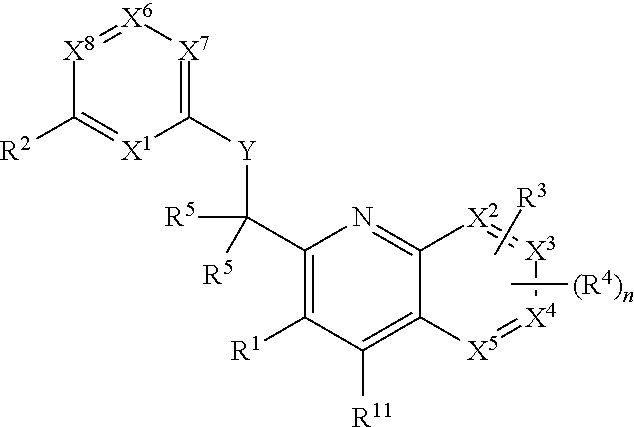Heterocyclic compounds and their uses
a technology of heterocyclic compounds and compounds, applied in the field of heterocyclic compounds and their, can solve the problems of limited utility of these compounds in studying the roles of individual class i pi 3-kinases, compounds that are non-specific pi3k inhibitors, and unfulfilled understanding of individual isoforms
- Summary
- Abstract
- Description
- Claims
- Application Information
AI Technical Summary
Benefits of technology
Problems solved by technology
Method used
Image
Examples
specific example
Method A
Synthesis of (2-amino-3-fluorophenyl)methanol
[0198]
[0199]To a round bottomed flask containing 2-amino-3-fluorobenzoic acid (15.7 g, 101 mmol) was added 100 mL of anhydrous THF. The reaction was cooled to 0° C. and lithium aluminum hydride (7.68 g, 202 mmol) was added as a solution in 200 mL of anhydrous Et2O. The reaction was allowed to warm to rt and stirred for 3 h, after which time it was quenched with 7.7 mL water, 7.7 mL of 15% NaOH, and 30 mL of water. The reaction was diluted with 300 mL of Et2O and filtered. The filtrated was dried over MgSO4 and filtered and concd to afford (2-amino-3-fluorophenyl)methanol. 1H NMR (400 MHz, CDCl3) δ 6.91 (ddd, J=10.8, 8.2, 1.2 Hz, 1H), 6.86 (br d, J=7.4 Hz, 1H), 6.64 (td, J=7.6, 5.1 Hz, 1H), 4.69 (s, 1H).
2-Amino-3-fluorobenzaldehyde
[0200]
[0201](2-Amino-3-fluorophenyl)methanol (13.5 g, 96 mmol) was dissolved in 319 mL of DCM. Manganese dioxide (66.5 g, 765 mmol, 8 eq) was added and the resultant slurry was stirred at rt overnight. Th...
example 1
Preparation of N-((5-chloro-3-(3-fluorophenyl)quinolin-2-yl)-methyl)-9H-purin-6-amine
2,5-Dichloroquinolin-3-ylboronic acid
[0222]
[0223]To a cold solution of diisopropylamine (2.2 mL, 1.1 eq) in THF (33 mL) was added drop-wise a solution of n-BuLi (1.1 eq, 2.5M, 6.2 mL) in hexane at −20° C. The resulted LDA solution was kept in 0° C. for 30 min and cooled to −78° C. before addition of a solution of 2,5-dichloroquinoline (J. Am. Chem. Soc. 2005, 127, 12657) (2.8 g, 14 mmol) in THF (14 mL) drop-wise. The temperature was controlled below −72° C. by adjusting the addition rate (15 min). After another 5 min, trimethyl borate (2.4 mL, 1.5 eq) was added drop-wise. After 30 min, the reaction was quenched with water, acidified to pH 4 and partitioned between EtOAc (50 mL) and water (100 mL). The combined organics were washed with water, brine, dried over Na2SO4. Removal of solvent gave a pale yellow solid which was washed with EtOAc (10 mL×2) followed with hexane (10 mL). A pale yellow solid w...
example 2
Preparation of N—((S)-1-(5-chloro-3-(3-fluorophenyl)quinolin-2-yl)ethyl)-9H-purin-6-amine, and Example 3: N—((R)-1-(5-chloro-3-(3-fluorophenyl)-quinolin-2-yl)ethyl)-9H-purin-6 amine
[0230]
[0231]To a solution of 5-chloro-3-(3-fluorophenyl)quinoline-2-carbaldehyde (80 mg, 0.28 mmol) in THF (2 mL) at 0° C. was slowly added MeMgBr (1.2 eq, 0.11 mL). The reaction mixture was stirred at 0° C. for 3 hr. After removal of solvent, the residue was triturated with water and 70 mg crude product was obtained. To a solution of 1-(5-chloro-3-(3-fluorophenyl)quinolin-2-yl)ethanol (70 mg, 0.23 mmol) in THF (2 mL) were added PPh3 (73 mg, 1.2 eq), phthalimide (41 mg, 1.2 eq), and DIAD (56 mg, 1.2 eq). The reaction mixture was stirred at rt for 2 h. LC-MS detected clear product peak. After removal of solvent, the residue was partitioned between EtOAc and water, and the combined organic layers were dried over Na2SO4. After removal of solvent, the crude residue was subjected to combi-flash chromatography ...
PUM
| Property | Measurement | Unit |
|---|---|---|
| temperature | aaaaa | aaaaa |
| temperature | aaaaa | aaaaa |
| temperature | aaaaa | aaaaa |
Abstract
Description
Claims
Application Information
 Login to View More
Login to View More - R&D
- Intellectual Property
- Life Sciences
- Materials
- Tech Scout
- Unparalleled Data Quality
- Higher Quality Content
- 60% Fewer Hallucinations
Browse by: Latest US Patents, China's latest patents, Technical Efficacy Thesaurus, Application Domain, Technology Topic, Popular Technical Reports.
© 2025 PatSnap. All rights reserved.Legal|Privacy policy|Modern Slavery Act Transparency Statement|Sitemap|About US| Contact US: help@patsnap.com



